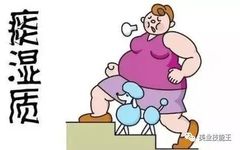Phlegm-damp constitution refers to a condition where the functions of the internal organs are disordered, leading to Qi, blood, and body fluids being improperly transformed and transported, resulting in the accumulation of dampness and phlegm. This condition often manifests as obesity, fullness in the abdomen, chest tightness, excessive phlegm, easy fatigue, a heavy sensation in the body, a preference for rich and fatty foods, a swollen tongue, and a white greasy tongue coating. It is commonly caused by invasion of cold-dampness, irregular diet, congenital constitution, aging, chronic illness, and lack of exercise. Symptoms may vary depending on the location of phlegm-damp retention, with a tendency to easily develop conditions such as diabetes, stroke, and chest obstruction, and poor adaptability to the plum rain season and damp environments. The primary treatment principle is to dry dampness and resolve phlegm, while also focusing on improving the phlegm-damp constitution to prevent the occurrence of phlegm-damp diseases.

The occurrence of phlegm-damp constitution is often due to various causes leading to dysfunction of the internal organs’ Qi transformation, improper transportation of Qi, blood, and body fluids, accumulation of dampness, and the formation of phlegm, which then obstructs the internal organs and further affects their function.
1. The causes of phlegm-damp constitution generally include the following:
1. Invasion of cold-dampness
Humid climate, exposure to rain or water, or prolonged residence in damp areas can lead to the invasion of dampness into the body, affecting the spleen and stomach, impairing the transformation of fluids, and resulting in the accumulation of dampness and phlegm.
2. Irregular diet
Frequent overeating or excessive consumption of rich and fatty foods can damage the spleen and stomach, preventing them from properly distributing the essence of food and transforming fluids, leading to the internal generation of dampness and phlegm accumulation.
3. Congenital constitution
Individuals with a tendency towards stomach heat who consume excessive rich and fatty foods may experience impaired spleen function, leading to dampness and phlegm accumulation.
4. Aging and chronic illness
Weakness of the spleen and stomach, reduced transformation function, or kidney Yang deficiency can hinder the transformation of Qi and the movement of fluids.
5. Lack of exercise
Long-term sedentary behavior can lead to poor circulation of Qi and blood, sluggish spleen and stomach function, and inability to transform fluids, resulting in the internal generation of dampness and phlegm.
Common manifestations of phlegm-damp constitution include obesity, fullness in the abdomen, chest tightness, excessive phlegm, easy fatigue, a heavy sensation in the body, a preference for rich and fatty foods, a swollen tongue, and a white greasy tongue coating. Symptoms may vary depending on the location of phlegm-damp retention, with a tendency to easily develop conditions such as diabetes, stroke, and chest obstruction, and poor adaptability to the plum rain season and damp environments.
2. Diagnostic methods for phlegm-damp constitution:
1. Phlegm-damp in the lungs
Manifestations: recurrent cough, excessive sticky or thick phlegm, white or grayish color, worsened by sweet and greasy foods, fatigue, white greasy tongue coating, and slippery pulse.
Regulation: dry dampness, resolve phlegm, warm the lungs, and descend rebellious Qi.
2. Phlegm-damp obstructing the middle
Manifestations: abdominal fullness and discomfort, worsened by eating, chest tightness, dizziness, heavy sensation in the body, nausea and vomiting, poor appetite, bland taste, normal or loose stools, thick greasy tongue coating, and submerged slippery pulse.
Regulation: dry dampness, resolve phlegm, regulate Qi, and harmonize the middle.
3. Phlegm-damp obstructing the orifices (phlegm obstructing the clear orifices)
Manifestations: heavy head, chest tightness, nausea, vomiting phlegm and saliva, poor appetite, excessive sleepiness, thick greasy tongue coating, and submerged slippery pulse.
Regulation: dry dampness, resolve phlegm, strengthen the spleen, harmonize the stomach, and pacify the liver to calm wind.
Symptoms of phlegm-damp constitution are diverse, and the primary treatment principle should focus on drying dampness and resolving phlegm.
3. Preventive health methods for phlegm-damp constitution:
Individuals with phlegm-damp constitution should develop good dietary habits, avoid rich, fatty, and cold foods, quit smoking and drinking, and regularly consume ginger, as well as vegetables and fruits rich in fiber and vitamins to maintain normal bowel movements. Since “the spleen is the source of phlegm production, and the lungs are the storage for phlegm,” individuals with phlegm-damp constitution should avoid exposure to water and rain, prolonged residence in damp areas, and pay attention to warmth to prevent external cold-dampness from harming the spleen. Special care should be taken during the plum rain season to avoid dampness. Regular participation in physical exercise is recommended, with moderate sweating to promote smooth circulation of Qi and blood.
You may also like the following content:
What Are the Manifestations of Phlegm-Damp Constitution? How to Regulate It?
Four Key Acupuncture Points to Eliminate Phlegm-Damp, Ideal for Weight Loss and Edema-Type Obesity.
How to Regulate a Hot-Above Cold-Below Constitution!
For Those Prone to Obesity, This Acupuncture Point Can Help Improve It.
Professional Knowledge on Meridian and Acupuncture Health.
For sales learning, follow the public account below:
Beauty industry professionals also follow the public account below:

